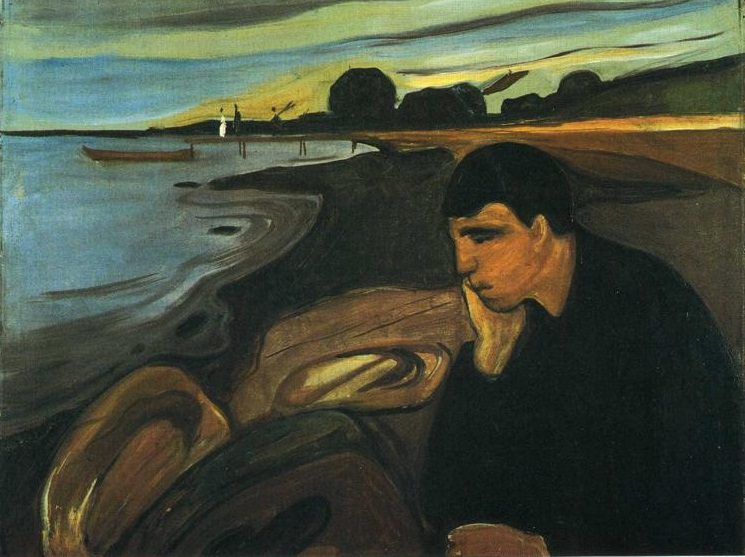Home » Topics / Subgenres » Reflection / Meditation
Category Archives: Reflection / Meditation
The Dream of the Rood
anonymous (Anglo-Saxon)
7th-8th century
(In a vision, the cross of Christ reflects with awe on its part in the death of God.)

“The most beautiful of the medieval religious poems”. This is often said of The Dream of the Rood. The first time I read this assessment—I had never even heard of the poem—it was by the Anglo-Saxon scholar R. K. Gordon in the colorful old Everyman Library series. The description as beautiful captured my attention. And it is beautiful. The vivid imagery, the incorporation of heroic and mystical themes, the profound devotion, the ethereal vision, the very language. Seeing such a work called beautiful is gratifying, for it highlights a virtue that is often languishing in recent religious literature, and religious sensibility in general. In both East and West, the enjoyment of beauty has frequently been marred by a suspicion that it may tempt one to elevate the lower over the higher, or to submit to illusory or distracting pleasure. Calling a religious poem “beautiful” recalls a time and a place when beauty was a central value in the building of churches, in the composition of sacred music, in devotional images and writings, and even in the grounds for the faith commitment itself. There have been times and places when the contemplation and enjoyment of beauty was widely embraced, on the idea, as Aristotle said, that “Beauty is the gift of God.”
Arnold’s early poems
Matthew Arnold
1840-1849
(A man of intellect and of spiritual sensitivity contemplates the purpose of life and its struggles.)

“Unwelcome shroud of the forgotten dead,/ Oblivion’s dreary fountain, where art thou”. What a dark way to begin one’s poetical efforts, at 18 years of age! And we need read no further to suspect (correctly) that in Matthew Arnold we are in for something very different from the Romantics, and quite different also from his Victorian contemporaries Browning and Tennyson. The essence of the distinction is in his preoccupation with the meaning of life, and by extension death and the loss of faith. This spiritual decline that disturbed him so much, often called the maladie du siècle or the “sickness of the century”, had been treated more seriously on the continent, while in England Wordsworth, Keats, and Shelley were grasping at Nature or the humanism of the Greeks for their spiritual anchor. Arnold was a more melancholic, more skeptical poet, and doubted that the sickness could ever be cured, although he certainly loved the ancients (many of his early poems have classical subjects), and he also did look to nature for inspiration. Even as a teen he presaged the Existentialists, and indeed much of the spirit of the twentieth century, in trying to devise a way to preserve our spirituality and sense of wonder while being brutally honest about our mortality and the fleeting nature of all human endeavor. Matthew Arnold was a great poet not mainly because he was imaginative, morally sensitive, and wonderstruck, nor on the other hand because he was freethinking, scholarly, and skeptical; he was great because he was somehow both of these sorts of people at once. If his poetry could be said to have a single goal, it was to merge these two halves of his consciousness, the spiritual and the intellectual.
Breakfast of Champions
Kurt Vonnegut, Jr.
1973
(Little do a frustrated writer and a troubled car dealer realize, that their impolite author is using their journey to meet each other as an excuse to mastermind a deconstruction of modern values!)

Sort of The Temptation of St. Anthony, sort of by Rabo Karabekian, 1950. Sort of Sateen Dura-Luxe acrylic wall paint and day-glo tape. 20 x 16 feet. This can sort of be seen in the Midland City Art Gallery, to which it was sort of sold by the artist for $50,000.
A Vonnegut novel grows on you… like an exquisite acquired taste… or else a nagging corn on the foot. All three experiences are underestimated at first, and with time a realization dawns that there is something here that cannot be ignored. Some deride Breakfast of Champions as one of his “lesser”, although more popular, novels. For my part, I think that here we have a wine that is initially very peculiar on the palate, and its apparent confusion will conceal the vibrant undertones if one is not careful to taste it slowly and carefully. Or else, here we have a blasted gadfly of a corn that starts insidiously in a part of the foot’s ball that is unlikely to feel it until the thing has incubated for a mighty long time, insinuating deeply into one’s tissues. And when finally noticed, ouch does that root go deep!




The Honorary Consul
June 17, 2019 / 1 Comment on The Honorary Consul
Graham Greene
1973
(Argentinian revolutionaries abduct the wrong political figure by mistake, and one cynical acquaintance is the only one who cares… perhaps not even he does.)
Graham Greene, though a writer of great variety, is known for his “seedy” settings (he popularized the adjective, much to his regret) and the moral dimension of his very human characters. In these respects The Honorary Consul is an enduring and typical example of Greene’s style. Early in the book the protagonist Eduardo Plarr criticizes the romantic novelist Saavedra by saying that “life isn’t like” the way that author writes. Here Greene crafts a novel according to the alternative strategy; to show what life is like, with real people encountering real difficulties. The characters’ frail humanity and the ambivalence of their commitments will encourage us imperfect readers to relate honestly to them. The author refuses to vault skyward into heroism, idealism, wonder, or joy, perhaps as these are short-lived and usually confused in the real world. The good guys are bad enough to prevent us from admiring them, and the bad guys are good enough to prevent us from demonizing them. No character has an entirely appetizing mixture of traits, but no character is thoroughly distasteful either.
Like many readers, my gut draws me towards works whose moral distinctions rise into sharper relief—I enjoy esteeming my protagonists. If we insist on this criterion, Greene will not fare well. After meeting the main characters and following them around for a while, we might question whether they are likable enough company. Such readers must take a step of faith throughout the first 100 pages or so, that Greene is telling us a story that we will really care to read. Embarking on the book was for me like hearing the first few sentences of a party yarn that we fear might not be worth the patience. However, may no reader give up before realizing Greene’s purpose! The first impression fades and becomes irrelevant as one reads onward. The grayscale characterization is not due to neglect or apathy on the part of the author. Far from it—the ambiguity represents a strategy conceived for a distinct moral purpose, as paradoxical as this seems. A novel need not be moralizing to be morally interesting. (more…)